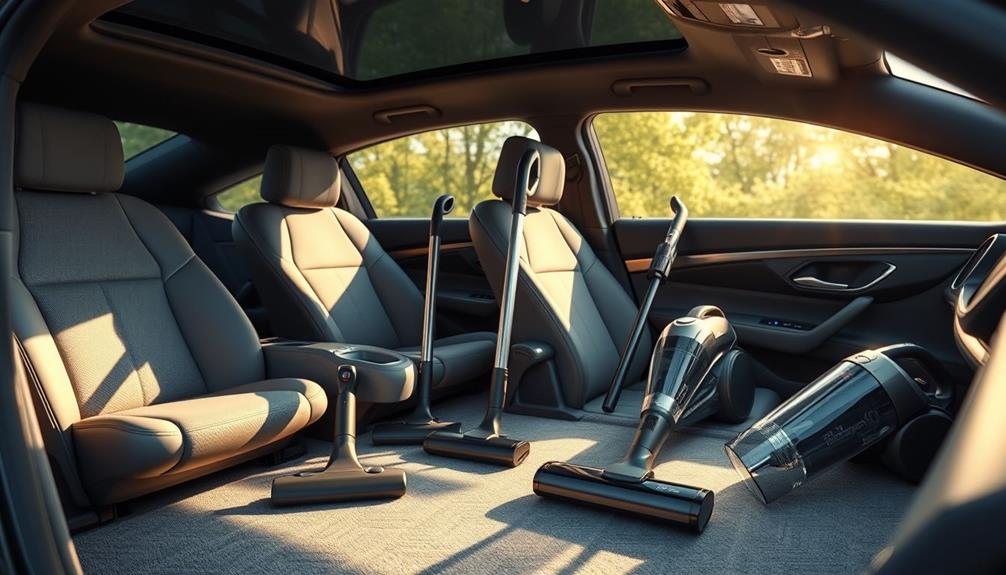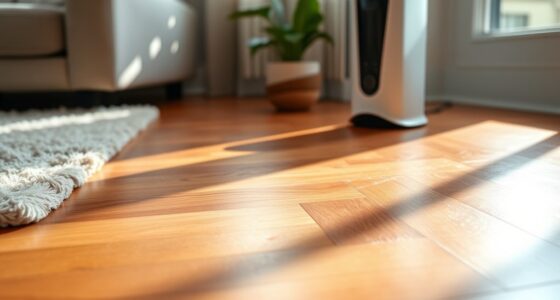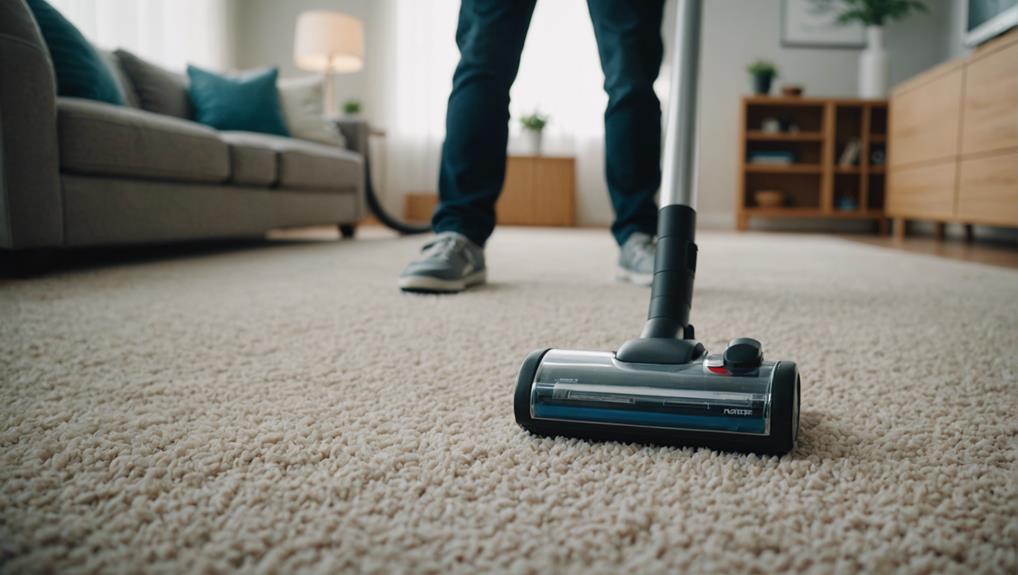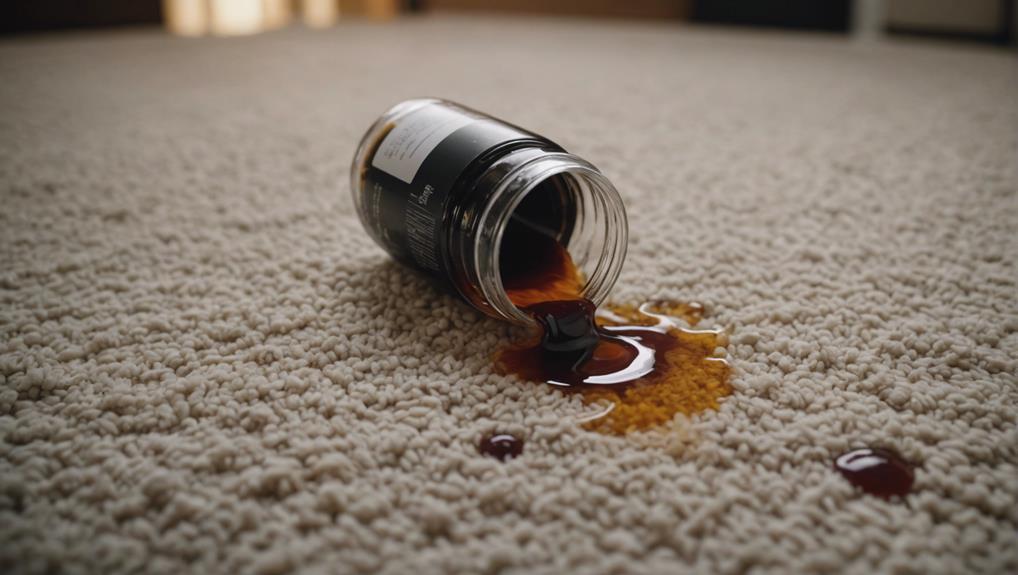You can utilize do-it-yourself carpet cleaning solutions for small stains or routine upkeep, using everyday household items such as vinegar and baking soda. However, if you encounter stubborn stains or strong odors, it is best to contact a professional. Experts possess specialized equipment and knowledge to address challenging issues efficiently, keeping your carpets in excellent condition. Keep in mind that although DIY methods can save money, they may not deliver the deep clean required, especially in the long run. Continue to explore for additional tips on carpet maintenance and when to seek professional assistance.
Key Takeaways
- Use DIY carpet cleaning methods for minor stains and regular maintenance to save costs and utilize accessible household ingredients.
- Call a professional when facing deep-seated stains or odors that require specialized equipment and expertise for effective removal.
- Opt for DIY solutions for quick fixes between professional cleanings, but schedule deep cleanings every 12 to 18 months for optimal upkeep.
- Be cautious with DIY methods, as incorrect techniques may damage carpet fibers or leave sticky residues that attract more dirt.
- Consider professional services if allergies or health concerns are significant, as they offer thorough cleaning and improved air quality.
Benefits of DIY Carpet Cleaning
One of the biggest benefits of DIY carpet cleaning is the cost savings it offers. By taking on the task yourself, you can avoid the expense of professional carpet cleaning services, especially for small spills and regular maintenance.
Regular vacuuming and spot cleaning with homemade solutions can greatly reduce allergens and dirt, promoting a healthier living environment for you and your family. Additionally, engaging in healthy lifestyle practices can enhance your overall well-being, making you more mindful about your home environment.
Using common household ingredients like vinegar and baking soda makes DIY cleaning methods not only accessible but also environmentally friendly. You won't have to rely on harsh chemicals, which is a plus for your health and the planet.
Additionally, DIY carpet cleaning allows you the flexibility to clean at your convenience, eliminating the hassle of scheduling conflicts with service providers.
Understanding Professional Services

When it comes to carpet cleaning, understanding the advantages of professional services can make a significant difference in your home's cleanliness.
These experts employ advanced equipment, like truck-mounted systems, that deliver high water pressure and suction for effective deep cleaning. This means you can say goodbye to stubborn stains and allergens, ultimately improving your indoor air quality.
Additionally, what to look for in a home cleaning service can enhance your decision-making when choosing a carpet cleaning provider, guaranteeing that you select a reputable and skilled team.
Here are some key benefits of using professional services:
- Tailored cleaning methods: Professionals adapt techniques to suit various carpet types, preventing damage to delicate materials.
- Deep-seated stain removal: They excel at tackling tough stains that DIY solutions might miss.
- Eco-friendly solutions: Many companies use environmentally safe products that enhance effectiveness without compromising indoor air quality.
- Satisfaction guarantees: Most services offer guarantees, ensuring you're protected against any damage during the cleaning process.
- Healthier living environment: By removing allergens and dirt, you promote a healthier space for your family.
Investing in professional carpet cleaning solutions can save you time and guarantee a thorough clean, making it a worthwhile consideration in your cleaning regimen.
When to DIY Carpet Cleaning

For homeowners looking to maintain their carpets without breaking the bank, DIY carpet cleaning can be a practical solution. If you encounter small, fresh spills, acting quickly can prevent staining. Simple ingredients like baking soda or vinegar can work wonders for minor accidents, and incorporating health benefits of using butter can add a unique touch to your cleaning routine.
Regular vacuuming is also essential; it helps remove dust, dirt, and allergens, contributing to your carpet's longevity.
Spot cleaning is another effective DIY method for tackling minor stains. Test any cleaning solutions on inconspicuous areas first to avoid potential damage. This approach lets you handle everyday messes without the need for professional carpet cleaners.
DIY carpet cleaning is particularly budget-friendly, making it an excellent choice for those who want to prolong their carpet's life without spending a fortune.
However, it's vital to recognize when you should call in the pros. If you're faced with tough stains or if your carpets need deeper cleaning, it's wise to seek professional help. Balancing between DIY methods and knowing when to hire experts will keep your carpets looking their best while saving you money.
Signs You Need a Professional
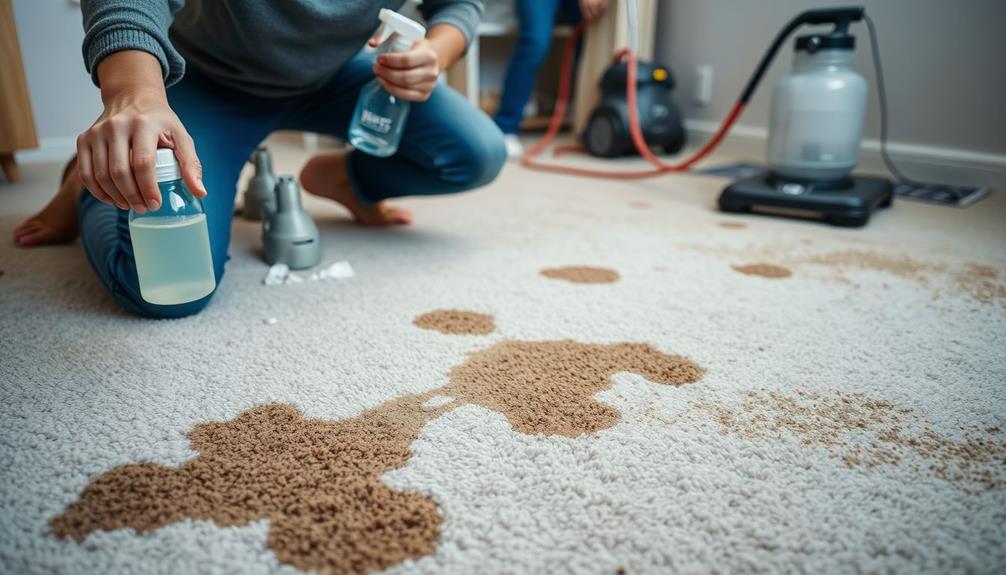
If persistent stains won't budge despite your best efforts, it's time to contemplate calling a professional.
For issues like deep-set stains or damage that may affect the underlying padding, relying on advanced cleaning solutions can be the best course of action.
Extensive carpet damage can also signal that DIY methods aren't enough to restore your flooring.
Recognizing these signs early can save you both time and money in the long run.
Persistent Stains Remain
Persistent stains that stubbornly cling to your carpets after numerous DIY cleaning attempts often signal it's time to call in the professionals.
These stains typically indicate that dirt or residue has penetrated deep into the carpet fibers, making your standard methods ineffective. Additionally, using the wrong vacuum, especially when cleaning carpets with embedded dirt, can exacerbate the problem.
Professionals have access to advanced carpet cleaning equipment and techniques that can tackle these stubborn issues effectively, including vacuums designed for tough jobs like best vacuums for pet hair.
Consider reaching out for professional help if you notice any of the following:
- Stains that have changed in color or size despite your efforts
- Residual odors that persist even after cleaning
- Stains caused by challenging substances like red wine, pet urine, or oil
- The presence of mold or trapped residue in the carpet
- Difficulty removing stains that require specialized treatments
Attempting to handle persistent stains on your own can lead to frustration and potentially worsen the situation.
By engaging a professional, you benefit from their expertise in identifying the best treatment methods and utilizing advanced cleaning solutions, ultimately restoring your carpets to their original condition.
Don't let these stains linger—professional help is just a call away!
Extensive Carpet Damage
Over time, extensive carpet damage can become increasingly evident, often displaying deep-seated stains that resist your DIY cleaning efforts. When you notice these stubborn stains, it's a clear sign that you need professional intervention to tackle the problem effectively.
Additionally, using an ozone air purifier can help neutralize odors that might linger after carpet cleaning, providing a fresher environment.
If your carpet shows signs of water damage, like discoloration or warping, addressing these issues requires specialized equipment and expertise. Ignoring these signs can lead to further deterioration, so don't wait too long to seek help.
Persistent odors, such as mustiness or pet smells, indicate underlying issues like mold or mildew. These problems can be challenging to identify and resolve without professional assistance.
Moreover, heavily soiled carpets from high foot traffic may also exhibit significant wear and tear. In such cases, professional cleaning can restore their appearance and prolong their lifespan.
Finally, if you own specialized carpet types, such as silk or wool, improper DIY techniques could cause irreversible damage. Professionals understand the unique care requirements for these materials and can guarantee your carpets are cleaned safely and effectively.
Don't hesitate to call in the pros when extensive carpet damage arises!
Cost Comparison: DIY Vs. Pro

When weighing the costs of DIY carpet cleaning solutions against professional services, it's important to take into account both immediate expenses and long-term value.
DIY methods can be tempting due to their low upfront costs, often as little as $0.05 per square foot. However, the cost comparison shows that professional cleaning, averaging $0.20 to $0.40 per square foot, may offer more lasting benefits.
Using specialized tools, like the Bissell Pet Hair Eraser Vacuum, can enhance your cleaning effectiveness, especially for pet owners.
Consider these factors:
- Initial Expense: DIY cleaning uses inexpensive ingredients like vinegar and baking soda.
- Long-term Costs: Inadequate cleaning may lead to more frequent need for professionals.
- Quality of Cleaning: Professionals use advanced equipment, ensuring a thorough clean.
- Carpet Longevity: Effective cleaning can extend the lifespan of your carpets, reducing replacement costs.
- Residue Issues: DIY solutions can leave sticky residues, attracting more dirt.
While DIY vs. professional cleaning might seem clear-cut initially, the long-term implications can shift the balance.
Ultimately, investing in professional services could save you money and hassle in the long run, making it a more prudent choice for maintaining your carpets.
Effective DIY Cleaning Techniques

Tackling carpet stains can feel intimidating, but using effective DIY cleaning techniques can make the process easier and more efficient. For your cleaning needs, start with a simple mixture of baking soda and vinegar. This combo lifts minor stains and odors, especially if you act quickly on fresh spills.
For localized stains, mix dish soap with water to blot and lift the stain without saturating the carpet fibers, ensuring you avoid any sticky residue. Notably, just as cats may show signs of stress during owner absence, allowing stains to set can create more anxiety about cleaning them cat behavior and emotional attachment.
If you're preparing for a thorough cleaning, consider pre-treating your carpets. Mix ½ cup of a suitable cleaner with a gallon of water, and apply it before your main cleaning session. When using DIY cleaning machines, hot water is your best friend—it activates solutions better than cold and penetrates fibers more effectively.
After applying your cleaning solutions, it's essential to extract excess moisture. A shop vac or extraction machine can help with this, preventing mold growth that thrives in damp conditions.
Potential Risks of DIY Methods
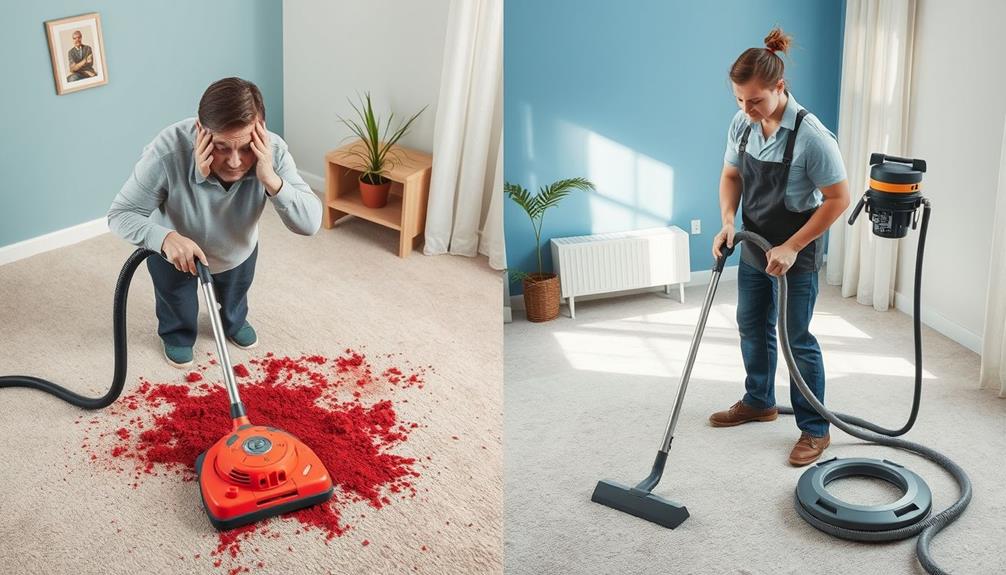
While DIY carpet cleaning can be cost-effective, it comes with potential risks that shouldn't be overlooked.
Using rental Carpet Cleaning Machines often leads to inadequate cleaning due to low water pressure and weak suction. As a result, you might find residues left behind in the carpet fibers, attracting dirt and causing them to soil faster. Additionally, some DIY cleaning solutions may contain essential oils, which, while beneficial for certain applications, can also result in oily residues if not properly diluted or applied. Understanding the benefits of essential oils can help you choose the right approach for your cleaning needs.
Here are some risks to evaluate:
- Damage to Carpet Fibers: Incorrect techniques or harsh chemicals can seriously damage your carpets, cutting their lifespan short.
- Excess Moisture: Over-saturating your carpets can lead to soggy conditions, which create an ideal environment for mold and mildew growth.
- Sticky Residues: Many homemade solutions may leave behind sticky residues that attract more dirt, necessitating frequent cleanings.
- Superficial Cleaning: Without professional-grade equipment, you're likely only achieving superficial cleaning, missing deep-seated grime and allergens.
- Time and Effort: DIY cleaning can be time-consuming, and the results may not justify the effort you put in.
Before diving into DIY methods, weigh these risks against the potential benefits to make an informed decision.
Advantages of Professional Cleaning
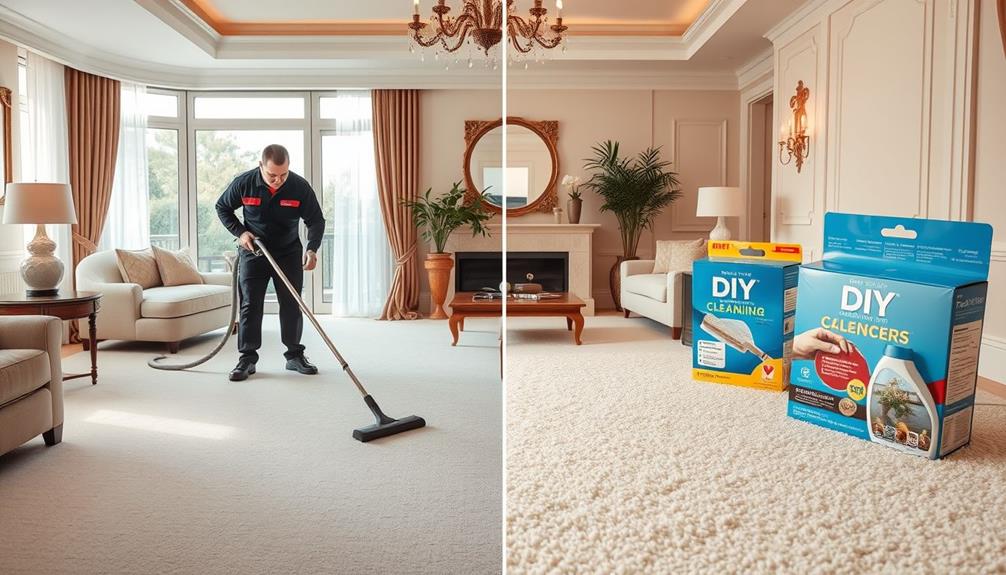
When you choose professional carpet cleaning, you're investing in deep cleaning efficiency that goes beyond what DIY methods can achieve.
These experts use advanced equipment and techniques tailored to your carpet's needs, ensuring a thorough clean that also improves your home's air quality.
Additionally, just like the best detailers in Chennai known for thorough cleaning techniques, professional cleaners can tackle tough stains and odors effectively.
Plus, with their specialized treatments, you'll enjoy a fresh, odor-free carpet that promotes a healthier living environment.
Deep Cleaning Efficiency
Achieving a truly deep clean for your carpets often requires the expertise and equipment that only professionals can provide. While DIY methods can help with surface cleaning, they often fall short when it comes to deep cleaning efficiency.
Professional carpet cleaning utilizes advanced techniques that guarantee your carpets get the thorough care they need.
- High water pressure and suction: Professionals use truck-mounted systems that effectively remove deep-seated dirt and stains.
- Hot water extraction: This method heats water to near-boiling, allowing for superior stain removal and odor elimination.
- Thorough cleaning: Experts clean both the surface and padding, reducing the risk of mold and mildew.
- Faster drying times: Specialized equipment guarantees your carpets dry quickly, minimizing unpleasant odors from dampness.
- Tailored solutions: Professionals use specialized solutions optimized for different carpet types, preventing damage and enhancing cleaning efficacy.
When it comes to carpet cleaning, relying on experienced professionals can save you time and provide results that DIY methods simply can't match.
With their specialized solutions and advanced techniques, you can trust that your carpets will look and feel their best.
Health Benefits
Professional carpet cleaning doesn't just enhance the appearance of your home; it also offers significant health benefits. When you hire professionals, they effectively remove allergens like pet hair, dust mites, and pollen, creating a healthier indoor environment. This is especially important if you or anyone in your family suffers from allergies or respiratory issues.
Moreover, regular professional cleaning helps reduce mold and mildew, which can thrive in damp carpet fibers. Improved air quality translates to better overall health for you and your loved ones. High-quality cleaning methods, like hot water extraction, eliminate harmful bacteria and viruses, contributing to a safer living space.
The thorough approach of professional cleaning not only boosts your carpets' aesthetic appeal but also extends their lifespan. This means less frequent replacements, which can pose health risks associated with deteriorating carpets.
Additionally, professional services use specialized equipment and eco-friendly cleaning solutions, minimizing harmful chemical exposure compared to some DIY methods.
Choosing the Right Cleaning Service
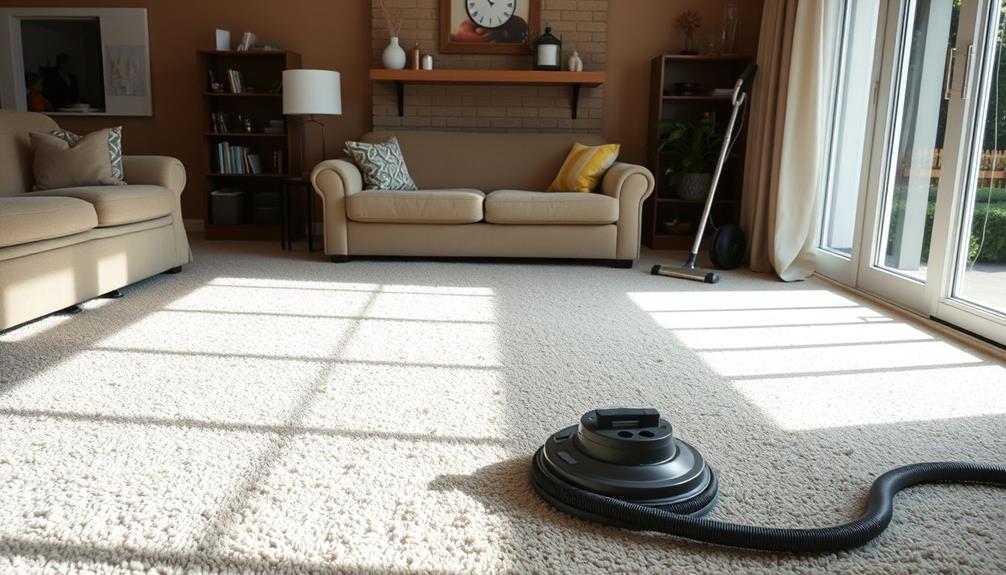
Selecting the right carpet cleaning service can make all the difference in maintaining your home's appearance and hygiene.
You want a company that aligns with your needs and delivers quality results. Here are some key factors to take into account:
- Reputation: Look for companies with strong reputations and positive customer reviews.
- Cleaning Methods: Inquire about their cleaning methods; while steam cleaning is popular, it mightn't be suitable for every carpet type.
- Cost Estimates: Obtain estimates from multiple providers to compare pricing and ascertain you're getting the right carpet cleaning for your budget.
- Insurance and Guarantees: Verify that the company is insured and offers guarantees, protecting you against potential damages.
- Flexibility: Seek companies that provide a variety of cleaning methods, as this can help address specific carpet issues more effectively.
Maintaining Carpet Health Long-Term
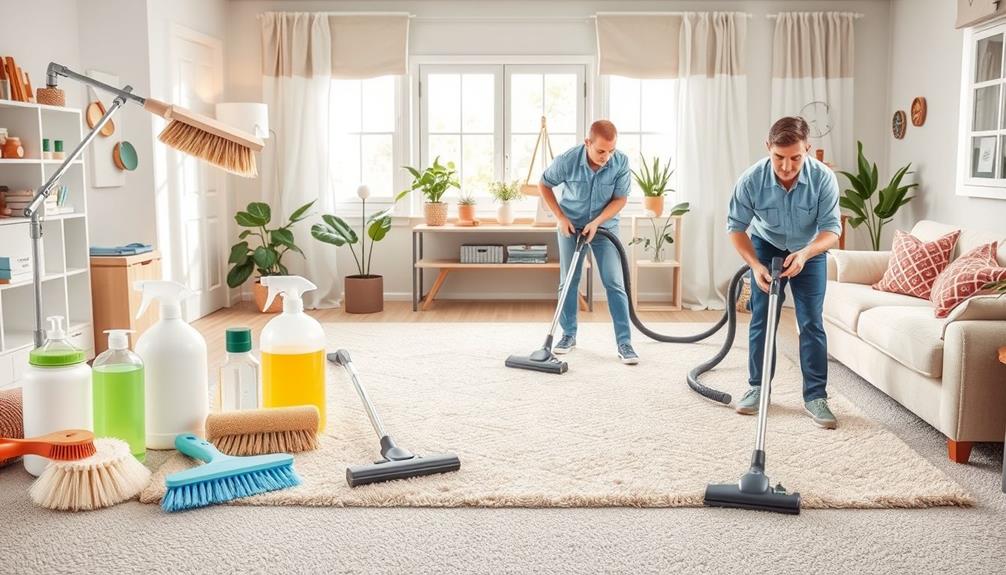
To keep your carpet looking its best, regular maintenance is key.
Vacuuming often and spot cleaning spills right away can save you from future headaches.
Plus, using safe cleaning products tailored to your carpet type guarantees you protect your investment for the long haul.
Regular Maintenance Importance
Regular carpet maintenance is essential for keeping your flooring in top shape and extending its lifespan.
By incorporating a few simple practices into your routine, you can maintain clean carpets and reduce the need for costly professional cleanings.
- Vacuum regularly to eliminate dirt, dust, and allergens.
- Spot clean small spills immediately to prevent permanent stains.
- Use DIY cleaning methods for quick touch-ups between professional cleanings.
- Rotate furniture occasionally to avoid uneven wear on your carpet.
- Schedule deep cleanings every 12 to 18 months for ideal results.
Choosing Safe Products
Finding the right carpet cleaning products is crucial for maintaining the health of your flooring over the long term. Prioritize eco-friendly solutions that are biodegradable, like those used in professional systems such as Rug Doctor® by BISSELL®. These products avoid heavy metals and harsh chemicals that can harm your carpet fibers and the environment.
Be cautious with homemade cleaning solutions; they can leave sticky residues that attract more dirt, ultimately leading to long-term damage. Always check for compatibility with your specific carpet type and adhere to manufacturer recommendations. This helps prevent voiding any warranties or causing damage with inappropriate products.
Regular use of professional-grade cleaning solutions can enhance your carpet's longevity by preserving protective coatings and preventing dirt and stains from accumulating.
Additionally, steer clear of mixing common household chemicals, as this can lead to dangerous reactions and potentially harmful substances, like toxic gas. Choosing safe, effective carpet cleaning products won't only keep your carpets looking great but also guarantee they remain healthy and vibrant for years to come.
Frequently Asked Questions
What Do Professional Carpet Cleaners Use for Solutions?
Professional carpet cleaners use specialized solutions tailored to various stains and carpet types.
These solutions often have 8-10 core ingredients that enhance their effectiveness compared to typical household cleaners.
You'll find eco-friendly options that avoid heavy metals and dyes, promoting better indoor air quality.
Brands like BISSELL® offer proprietary formulas designed for their rental machines, ensuring compatibility and ideal results.
This approach allows for quicker drying times and addresses tough issues like pet odors effectively.
Is Professional Carpet Cleaning Better Than Doing It Yourself?
Did you know that professional carpet cleaning can remove up to 98% of allergens?
When it comes to cleaning your carpets, professionals often outperform DIY methods. They use advanced equipment and techniques that reach deep stains and allergens, while you might leave behind residual detergent.
Although DIY can save money for minor stains, hiring a pro guarantees a thorough clean, extends your carpet's life, and saves you time and effort in the long run.
Does It Matter What Carpet Cleaner Solution You Use?
Yes, it definitely matters what carpet cleaner solution you use.
The right solution can enhance cleaning effectiveness, while the wrong one might leave residues that attract dirt. You wouldn't want to risk chemical reactions by mixing products, either.
If you have pets or specific stains, specialized solutions are tailored to tackle those issues better.
Choosing wisely guarantees your carpet stays clean longer and maintains a healthier indoor environment.
What Is the Most Effective Carpet Cleaning Method?
Did you know that steam cleaning can remove up to 95% of allergens from carpets?
When it comes to the most effective carpet cleaning method, steam cleaning stands out for its deep-cleaning capabilities, utilizing hot water extraction to tackle stubborn stains and odors.
If you need a quick touch-up, bonnet cleaning might suffice, but for thorough results, steam cleaning's heat and pressure make it the superior choice for maintaining a clean environment.
Conclusion
In summary, while DIY carpet cleaning can save you money and be effective for minor stains, it's essential to know when to call in the pros. Did you know that 80% of carpet cleaning professionals use hot water extraction, which can remove up to 98% of allergens? If your carpets are heavily soiled or have persistent odors, don't hesitate to reach out for expert help. Keeping your carpets clean not only enhances your home's appearance but also promotes a healthier living environment.

